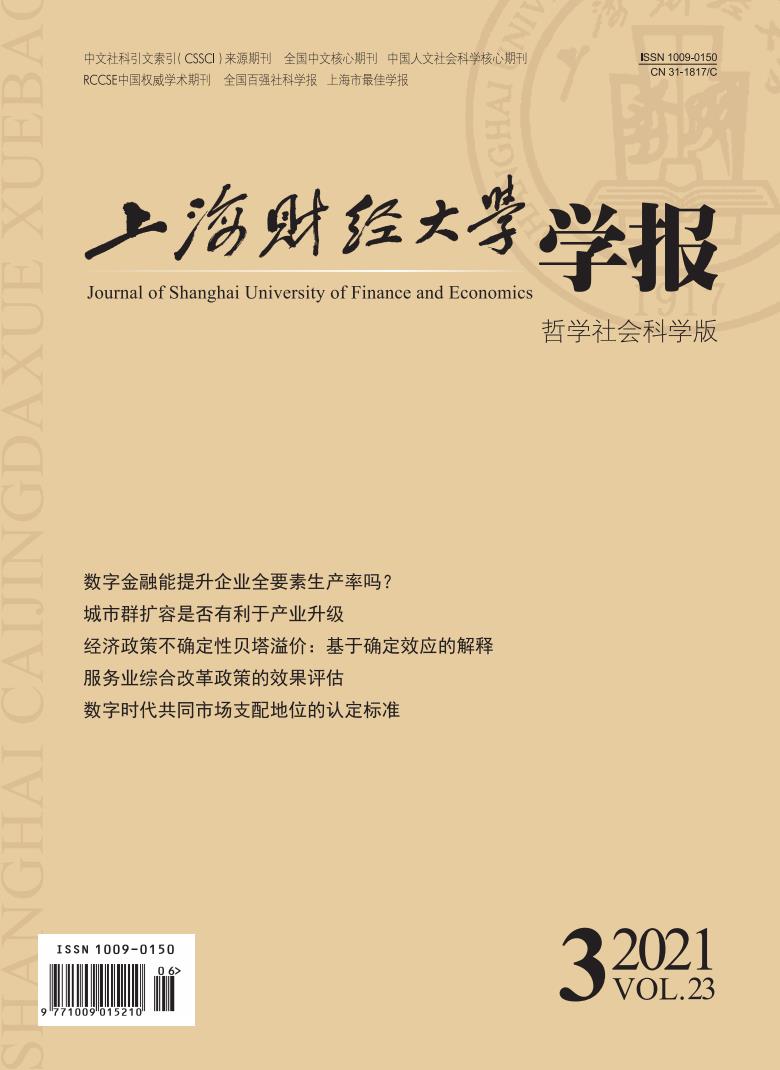当前,中国服务业高质量发展仍受到体制机制相对滞后的困扰,加快优化政策体系和发展环境、着力激发服务业发展新活力已刻不容缓。基于新经济地理学视角,文章在采用倾向得分匹配双重差分法解决选择性偏差与内生性问题的基础上,评估了服务业综合改革试点政策对服务业集聚发展的影响。结果显示:服务业综合改革有利于促进试点地区服务业集聚发展;且这种促进效应在东部地区、知识密集型服务业部门显著,而在东北地区、生活服务业部门不明显。进一步机制检验发现,服务业综合改革通过强化地区创新能力和提升劳动生产率推动了服务业集聚发展。进入“十四五”发展新阶段,应通过放宽市场准入、清理不合理限制条件、构建高效协同监管体系等方式纵深推进服务业综合改革,同时注重构建适应服务新业态新模式的技术创新环境,完善服务业劳动力市场的培育及激励机制,多措并举促进我国服务业繁荣发展。
服务业综合改革政策的效果评估——兼论体制机制创新助力高质量发展启示
摘要
参考文献
摘要
关键词
6 管驰明,高雅娜. 我国城市服务业集聚程度及其区域差异研究[J]. 城市发展研究,2011,(2). DOI:10.3969/j.issn.1006-3862.2011.02.019
10 姜长云. 应该重视提高我国服务业劳动生产率[J]. 中国发展观察,2018,(11). DOI:10.3969/j.issn.1673-033X.2018.11.017
12 蒋三庚. CBD与现代服务业企业集群研究[J]. 首都经济贸易大学学报,2006,(5). DOI:10.3969/j.issn.1008-2700.2006.05.013
16 刘志彪. 生产者服务业及其集聚:攀升全球价值链的关键要素与实现机制[J]. 中国经济问题,2008,(1). DOI:10.3969/j.issn.1674-8298.2012.04.016
24 王雪瑞. 生产性服务业集聚效应研究[J]. 管理学报,2014,(8). DOI:10.3969/j.issn.1672-884x.2014.08.020
26 夏杰长. 打破垄断和完善规制:深化现代服务业改革的关键所在[J]. 北京工商大学学报(社会科学版),2013,(3). DOI:10.3969/j.issn.1009-6116.2013.03.018
27 夏杰长, 倪红福. “十三五”时期促进服务业发展改革研究[M]. 北京: 社会科学文献出版社, 2016.
33 Baron R M,Kenny D A. The moderator-mediator variable distinction in social psychological research:Conceptual,strategic,and statistical considerations[J]. Journal of Personality and Social Psychology,1986,51(6):1173–1182. DOI:10.1037/0022-3514.51.6.1173
34 Bertrand M,Duflo E,Mullainathan S. How much should we trust differences-in-differences estimates?[J]. The Quarterly Journal of Economics,2004,119(1):249–275. DOI:10.1162/003355304772839588
35 Cai X Q,Lu Y,Wu M Q,et al. Does environmental regulation drive away inbound foreign direct investment?Evidence from a quasi-natural experiment in China[J]. Journal of Development Economics,2016,123:73–85. DOI:10.1016/j.jdeveco.2016.08.003
36 Elliott P V. Intra-metropolitan agglomerations of producer services firms: The case of graphic design firms in metropolitan Melbourne, 1981–2001[D]. Melbourne: The University of Melbourne, 2005: 1–162.
37 Ellison G,Glaeser E L,Kerr W R. What causes industry agglomeration?Evidence from coagglomeration patterns[J]. American Economic Review,2010,100(3):1195–1213. DOI:10.1257/aer.100.3.1195
38 Fan S G,Li L X,Zhang X B. Challenges of creating cities in China:Lessons from a short-lived county-to-city upgrading policy[J]. Journal of Comparative Economics,2012,40(3):476–491. DOI:10.1016/j.jce.2011.12.007
39 Guan J C,Yam R C M,Tang E P Y,et al. Innovation strategy and performance during economic transition:Evidences in Beijing,China[J]. Research Policy,2009,38(5):802–812. DOI:10.1016/j.respol.2008.12.009
40 Hanson G H. Market potential,increasing returns and geographic concentration[J]. Journal of International Economics,2005,67(1):1–24. DOI:10.1016/j.jinteco.2004.09.008
41 Heckman J J,Ichimura H,Todd P E. Matching as an econometric evaluation estimator:Evidence from evaluating a job training programme[J]. The Review of Economic Studies,1997,64(4):605–654. DOI:10.2307/2971733
42 Illeris S,Philippe J. Introduction:The role of services in regional economic growth[J]. The Service Industries Journal,1993,13(2):3–10. DOI:10.1080/02642069300000025
43 Krugman P. Increasing returns and economic geography[J]. Journal of Political Economy,1991,99(3):483–499. DOI:10.1086/261763
44 La Ferrara E,Chong A,Duryea S. Soap operas and fertility:Evidence of Brazil[J]. American Economic Journal:Applied Economics,2012,4(4):1–31.
45 Marshall A. Principles of economics[M]. 8th ed. London: Macmillan, 1948.
46 Meliciani V,Savona M. The determinants of regional specialisation in business services:Agglomeration economies,vertical linkages and innovation[J]. Journal of Economic Geography,2015,15(2):387–416. DOI:10.1093/jeg/lbt038
47 Ning L T,Wang F,Li J. Urban innovation,regional externalities of foreign direct investment and industrial agglomeration:Evidence from Chinese cities[J]. Research Policy,2016,45(4):830–843. DOI:10.1016/j.respol.2016.01.014
48 Nordhaus W D. Productivity growth and the new economy[R]. NBER Working Paper, 2001.
49 Scott A J. Flexible production systems and regional development:The rise of new industrial spaces in North America and western Europe[J]. International Journal of Urban and Regional Research,1988,12(2):171–186. DOI:10.1111/j.1468-2427.1988.tb00448.x
50 Xue Y W,Ye X T,Zhang W,et al. Reverification of the“resource curse”hypothesis based on industrial agglomeration:Evidence from China[J]. Journal of Cleaner Production,2020,275:124075. DOI:10.1016/j.jclepro.2020.124075
51 Zhang D Y,Rong Z,Ji Q. Green innovation and firm performance:Evidence from listed companies in China[J]. Resources,Conservation and Recycling,2019,144:48–55. DOI:10.1016/j.resconrec.2019.01.023
52 Zhao X S,Lynch Jr J G,Chen Q M. Reconsidering Baron and Kenny:Myths and truths about mediation analysis[J]. Journal of Consumer Research,2010,37(2):197–206. DOI:10.1086/651257
引用本文
刘胜, 徐榕鑫, 陈秀英. 服务业综合改革政策的效果评估——兼论体制机制创新助力高质量发展启示[J]. 上海财经大学学报, 2021, 23(3): 79-94.
导出参考文献,格式为:






 3889
3889  3968
3968

